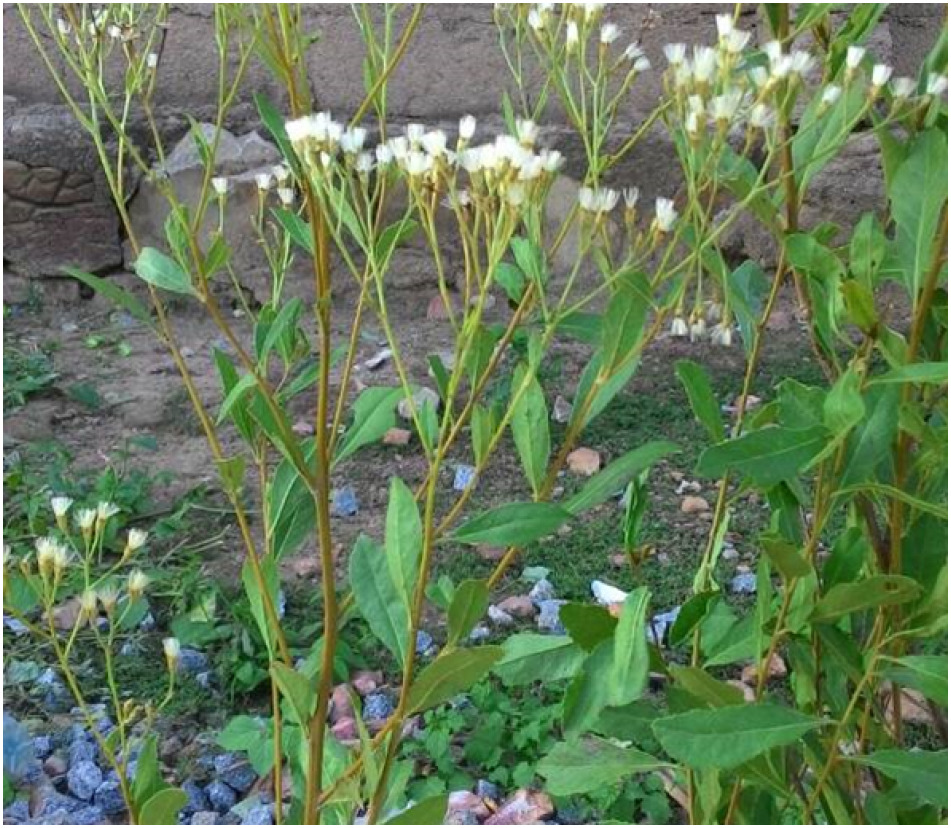Vernonia glaberrima

|
|
Scientific
Classification:
Synonyms: Species ID: NMP-285;wfo-0000095907; Common Names: Local Names: Shiwakaar, shiwaakar-jan-ga gari(Hausa) Basic Description: Gymnanthemum glaberrimum
is a much-branched subshrub, typically reaching up to 1 meter in height,
occasionally up to 2 meters. It often appears leafless or with emerging leaves
during flowering. The leaves are elliptic to oblanceolate, with subentire to
coarsely dentate-serrate margins, and are coriaceous in texture. The plant
produces numerous small, white, sweetly scented capitula arranged in panicles
or pseudumbels on short lateral branches. Distribution and
Habitat: This species is native to tropical
Africa, including countries such as Nigeria, Ghana, Cameroon, and extending to
East and Southern Africa. It thrives in various types of woodland and savanna
habitats, often found in open hillside grasslands and Brachystegia woodlands,
at altitudes ranging from 600 to 1,800 meters. Medicinal Properties: Antimalarial Activity Studies have demonstrated that the
methanolic leaf extract of V. glaberrima exhibits significant
antimalarial effects. In vivo experiments using Plasmodium berghei-infected
mice showed dose-dependent parasite suppression, with the highest dose
achieving 62.1% suppression, comparable to chloroquine's 73.4%. This supports
the traditional use of the plant in malaria treatment. The methanolic leaf extract of V.
glaberrima has demonstrated notable antimicrobial activity against various
bacterial and fungal strains. Research indicates that the extract contains
bioactive compounds effective against pathogens, validating its traditional use
in treating infections. Analgesic and Anti-inflammatory Effects Lupeol, a compound isolated from the
n-hexane fraction of V. glaberrima leaf extract, has been shown to
possess significant analgesic and anti-inflammatory activities. Experimental
models revealed that lupeol effectively reduced pain responses and
inflammation, supporting the plant's ethnomedicinal application in managing
pain and inflammatory conditions. Antidiabetic Potential Preliminary studies suggest that the
methanolic leaf extract of V. glaberrima may have antidiabetic
properties. Phytochemical screening has identified the presence of compounds
that could contribute to blood glucose regulation, indicating potential
benefits in diabetes management. Treatment of skin cancer Vernonia
glaberrima is a medicinal plant that is used in African traditional medicine
for the treatment of skin cancer. Recent study find out that the Crude
methanolic leaves extract of V. glaberrima showing significant cytotoxic
activity against cancer cell lines was subjected to chromatographic separation,
purification and hydrolysis to yield four compounds namely, nonacosanoic acid,
lupeol, 5-methylcoumarin-4-β-glucoside and
4-hydroxy-5-methylcoumarin. Three of the isolated compounds showed significant cytotoxic activity against
human malignant melanoma (A375) cell line (IC50: 59.18 ± 2.70 to 139.53 ± 10.79
μg/mL) and human caucasian colon adenocarcinoma
(HT-29) cell line
(IC50: 4.22 ± 0.13 to 20.0 ± 1.91 μg/mL) while only lupeol displayed significant
activity against human breast adenocarcinoma (MCF7) (IC50: 34.15 ± 2.32 μg/mL) cell line. CDK2 receptor and CAIX were
identified through molecular docking as potential targets for the bioactive
compounds. The findings of
this study have revealed the therapeutic potential of V. glaberrima against
breast cancer, skin cancer and colorectal carcinoma, respectively and further
support its traditional uses in the treatment of skin cancer Phytochemical Composition Phytochemical analyses of V.
glaberrima have identified various bioactive constituents, including
alkaloids, flavonoids, saponins, and terpenoids. These compounds are associated
with the plant's therapeutic effects, such as antimicrobial, anti-inflammatory,
and antidiabetic activities. Safety Profile Acute toxicity studies indicate that
the methanolic leaf extract of V. glaberrima has a median lethal dose
(LD50) of approximately 1265 mg/kg in mice, suggesting a relatively safe
profile at therapeutic doses. However, further studies are necessary to fully
establish its safety in humans. Known Toxicity: There is limited information regarding
the toxicity of G. glaberrimum. However, caution is advised when using
plants from this genus medicinally, as some species contain compounds that can
be toxic if misused. Proper identification and preparation are essential to
ensure safety. Additional
Information: The reclassification of Vernonia
glaberrima to Gymnanthemum glaberrimum reflects ongoing taxonomic
revisions within the Asteraceae family, aimed at better understanding the
relationships and characteristics of these plants. Such taxonomic updates are
crucial for accurate identification, which is essential for both botanical research
and the safe use of plants in traditional medicine. References:
External links
|
|
| Compounds of Vernonia glaberrima | |
| References |